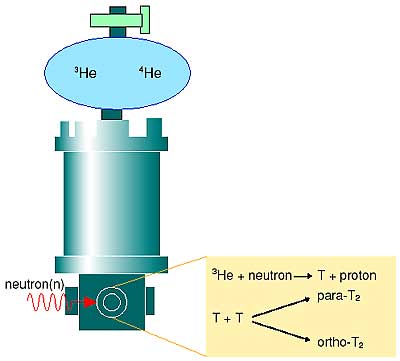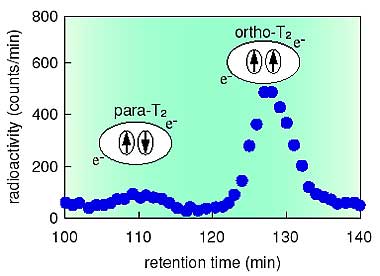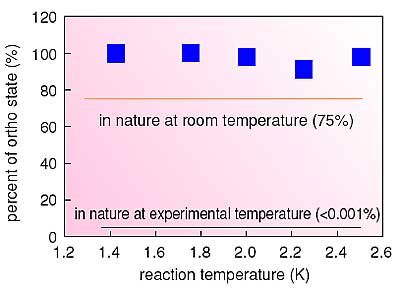Nuclear transformation caused by neutrons permits the generation of a naturally low-abundance radioactive isotope - i.e. an element with different mass. The radioactive isotope generated can be detected with very high sensitivity through its radioactivity.
This capability of neutrons has led us to produce tritium, which is a radioactive hydrogen isotope and has very low natural abundance, through the nuclear transformation of helium-3 (3He) in the liquid phase at the Japan Research Reactor No. 3M (JRR-3M). This development has enabled us to succeed for the first time in observing the recombination reaction of tritium, T+T T2, at very low temperature (1.4-2.5K). Although the recombination reaction among hydrogen isotopes (hydrogen, deuterium and tritium [T]) is the most fundamental chemical reaction, its mechanism has not been well established up to now. T2, at very low temperature (1.4-2.5K). Although the recombination reaction among hydrogen isotopes (hydrogen, deuterium and tritium [T]) is the most fundamental chemical reaction, its mechanism has not been well established up to now.
The nucleus of tritium has spin quantum number of 1/2, and since there are two spin directions, the T2 molecule formed by the recombination reaction (Fig. 4-17) has two spin isomers, that is, ortho-T2 (parallel nuclear spin) and para-T2 (antiparallel nuclear spin). From the ratio of ortho-T2 to para-T2 formed, it is possible to understand the mechanism of the recombination reaction.
Fig. 4-18 and 4-19 show strongly preferential formation of ortho-T2. Based on these experimental results and rotational selection rules, it is concluded that T2 molecules are formed through a metastable state with an odd rotational quantum number.
As a consequence of using neutrons to generate tritium, then, substantial progress has been made in clarifying the fundamental chemical reaction among hydrogen isotopes. |



 T2, at very low temperature (1.4-2.5K). Although the recombination reaction among hydrogen isotopes (hydrogen, deuterium and tritium [T]) is the most fundamental chemical reaction, its mechanism has not been well established up to now.
T2, at very low temperature (1.4-2.5K). Although the recombination reaction among hydrogen isotopes (hydrogen, deuterium and tritium [T]) is the most fundamental chemical reaction, its mechanism has not been well established up to now.